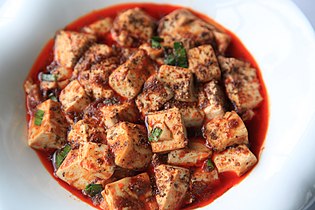Ba–Shu culture

Ba-Shu culture (Chinese: 巴蜀文化; pinyin: Bāshǔ wénhuà) refers to a regional culture centered around Sichuan province and Chongqing city, also encompassing parts of Yunnan, Guizhou and neighboring regions which speak Southwestern Mandarin. Historically centered around the Yangtze River, it emerged as an amalgamation of the cultures of the Shu and Ba kingdoms after their conquest by the Qin Dynasty. The discovery of the Shu site of Sanxingdui in 1986 and Jinsha in 2001 places the Ba-Shu culture's age at nearly four millenia old;[2][3] consequently, it is widely considered to be one of the cradles of Chinese civilisation and culture.[4][5][6]
The continuous use of the name Shu to refer to the Sichuan region throughout history has contributed to the Ba-Shu culture's survival (even today, one of the official names of Sichuan is Shu).[7] As a result, the Ba-Shu culture continues to the present day and is famous for aspects such as its cuisine and Sichuan opera.
Origins[edit]
Shu culture[edit]

The ancient kingdom of Shu originated from the Sanxingdui culture and thrived during the Xia Dynasty, lasting a total of one or two millenia.[8] The Shu culture had a rich tradition of metalworking (especially with bronze) and manufactured numerous notable artifacts, hundreds of which were unearthed at sacrificial pits at Sanxingdui and Jinsha; these include bronze statues, heads and masks, several bronze trees (one of which, the Bronze Sacred Tree, has been restored), daggers, hundreds of pieces of pottery, and the Golden Sun Bird.[9][10] Additionally, the Shu culture is noted for its resistance to external influences, and was more or less unaffected by other nearby cultures until its conquest by the Qin Dynasty in 316 BC.[11][12]
Ba culture[edit]
Ba culture and the State of Ba were historically centered around the Three Gorges area.[13] The Ba people worshiped the white tiger, which was their totem, and crafted many bronze artifacts based on its form and patterns.[14][15] Additionally, they had a rich tradition of performing arts, with distinctive instruments and ritual dances like the Bayu Dance.[16][17] However, there is a lack of identifiable artifacts belonging to the Ba culture because nearly all of them have been mixed with relics of other nearby kingdoms. Additionally, there is an absence of written records about Ba culture made in the same time period by the Shang dynasty or any other states. As a result, not much is known about ancient Ba culture.[18]
Ancient writing system[edit]

Traditional language[edit]
Architecture[edit]

Sichuanese architecture[edit]
Sichuanese garden[edit]
Visual arts[edit]


Performing arts[edit]
Clothing[edit]
Food culture[edit]
Others[edit]
- Religious sites in Sichuan
-
Golden Temple of Mount Emei of the Chinese Buddhist tradition.
-
Statues of buddhas at a Litang monastery of the Tibetan Buddhist tradition.
-
St. Joseph's Cathedral, Chongqing (Catholic).
See also[edit]
External links[edit]
References[edit]
- ^ Li, Hsing-jung; Fêng, Ming-i; Yü, Chih-yung (November 1, 2014). 導遊實訓課程 (in Traditional Chinese). Taipei: E-culture. p. 331. ISBN 9789865650346.
- ^ Zhao, Weijie. "New archeological marvels of ancient Shu civilization". academic.oup.com. Archived from the original on April 18, 2024. Retrieved February 23, 2024.
- ^ "Jinsha Site Museum". www.jinshasitemuseum.com. Archived from the original on April 18, 2024. Retrieved February 24, 2024.
- ^ Liu, Hong (June 2006). "巴蜀文化渊源". huaxia.com (in Chinese). Archived from the original on May 2, 2019. Retrieved September 7, 2017.
- ^ 四川师范大学巴蜀文化中心. Center for Bashu Cultural Studies, Sichuan Normal University.
- ^ Liu, Hong. "巴族和蜀族怎樣構成巴蜀文化? | 中國文化研究院 - 燦爛的中國文明". chiculture.org.hk (in Chinese). Archived from the original on April 18, 2024. Retrieved April 18, 2024.
- ^ "People's Government of Sichuan Province". www.sc.gov.cn. Retrieved February 24, 2024.
- ^ "【巴蜀文化】天府人间,辉映流光 - 青陇巴蜀 - 汗青网". web.archive.org. March 4, 2016. Retrieved April 5, 2024.
- ^ "Bronze sacred tree found in Sanxingdui sacrificial pit – The History Blog". September 9, 2021. Retrieved April 5, 2024.
- ^ "Newly found Chinese artifacts illuminate mysterious ancient kingdom". NBC News. June 15, 2022. Retrieved April 5, 2024.
- ^ Luo, Zhitian (March 29, 2023). "【资讯】浅析巴蜀文化". Chengdu University of Technology. Archived from the original on April 5, 2024.
- ^ "Qin Dynasty: Achievements, Facts & Time Period". HISTORY. June 16, 2023. Retrieved April 5, 2024.
- ^ "巴文化的多元传播探究_光明日报_光明网". www.gmw.cn. Retrieved April 12, 2024.
- ^ "东西问丨巴文化何以成为中华文明的坚定"一元"?-中新网". www.chinanews.com.cn. Retrieved April 12, 2024.
- ^ "巴文化传统符号与旅游工艺品设计的融合 -《装饰》杂志官方网站 - 关注中国本土设计的专业网站 www.izhsh.com.cn". www.izhsh.com.cn. Retrieved April 12, 2024.
- ^ "巴文化 | 巴、蜀、楚的文化关系,你知道吗?_巴楚". www.sohu.com. Retrieved April 12, 2024.
- ^ "巴渝舞:巴人啸聚山林的狂欢盛宴_巴中市人民政府". www.cnbz.gov.cn. Retrieved April 12, 2024.
- ^ "巴文化研究若干问题的思考 - 重庆考古". www.cqkaogu.com. Retrieved April 12, 2024.







![Baba Mosque [zh], a Sichuanese Sufi mosque in Langzhong.](http://upload.wikimedia.org/wikipedia/commons/thumb/1/1f/%E5%B7%B4%E5%B7%B4%E5%AF%BA.JPG/225px-%E5%B7%B4%E5%B7%B4%E5%AF%BA.JPG)


